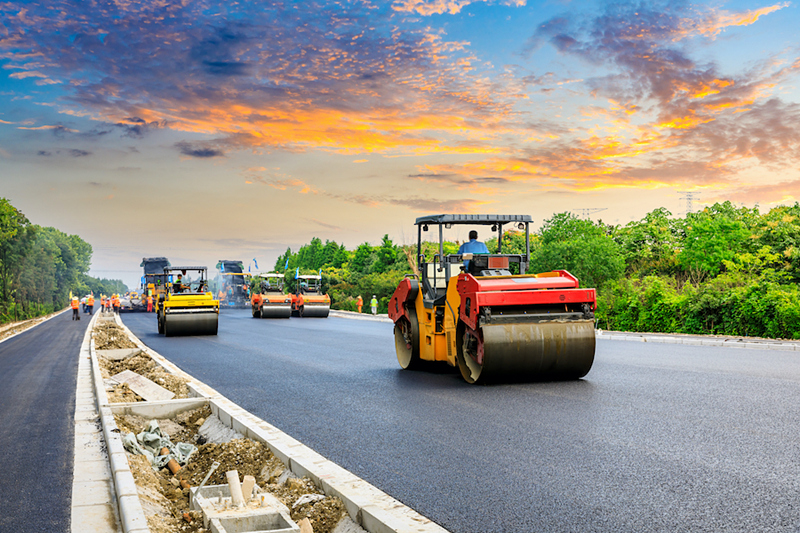In road engineering, the smoothness of asphalt pavement is directly related to the safety and comfort of driving. If the asphalt pavement is uneven, driving vehicles will produce additional vibrations, thereby aggravating the damage to the asphalt pavement. Although asphalt smoothness is one of many road technical indicators, in terms of road usage, asphalt smoothness is an important factor that affects the use function of the road. There are many factors that affect the smoothness of colored asphalt concrete pavement.
The effect of asphalt mixture
The gradation and mixing uniformity of mineral mixture directly affect the flatness of the road surface. If the gradation of mineral mixture changes greatly or the coarse and fine aggregates are separated, the compaction degree will change greatly in the short section of the road, and the inconsistent settlement under the action of driving load will lead to poor flatness.
Effect of base flatness on surface flatness
The pavement structure of the road is a layered structure system, which is generally composed of surface layer, base layer, bottom layer and cushion layer. In the pavement structure layer, the flatness of the next layer directly affects the quality of the flatness of the upper layer. The unevenness of the base layer will lead to the uneven thickness of the surface layer, which leads to the inconsistent settlement of the road surface under the same compaction work, resulting in the poor flatness of the road surface.
The influence of paver baseline
All pavers are equipped with floating ironing plates with automatic leveling. The use of automatic leveling device, need to have an accurate datum, commonly used datum line control has the datum wire method, sliding method and balance beam method.
Effect of paving operation
Influence of paver itself
Paver is the main equipment of asphalt pavement surface construction, and its own performance and operation have a great impact on paving flatness. Again, the paver computer has a reaction time, if the speed is too fast, it will lead to the reduction of the baseline effect or even loss of effect, resulting in the deviation of the paving thickness and the requirements, and the flatness of the road is poor.
Influence of paving width
The spiral feeder of the paver is too long to transport the mixture, which will inevitably cause the separation of coarse and fine aggregates. The temperature drops more to the side, resulting in uneven temperature and different compaction. The long part of the paver is just hanging on the paver, without the same vibrating equipment as the middle part, which looks very flat on the surface, but actually the compaction degree is not the same. Instead, it affects the horizontal subintegrality.
Iron plate adjustment and maintenance is not timely
The bottom of the ironing plate is worn or seriously deformed, and the paving layer is easy to produce cracks and pull trenches, which affect the flatness of the asphalt pavement.
Impact of rolling operation
When the roller moves forward, it turns the curve near the paver, and then reverses the wrong wheel, so it is easy to produce lateral movement in the unrolled section, which affects the flatness of the road surface.
If the rolling temperature is too high, it is easy to cause the passage of the paving layer, and it is difficult to form a stable structure during the final pressing. The temperature is too low, the mixture appears stiff phenomenon, the friction resistance between the aggregate becomes large, the compactness and flatness of the mixture are not easy to achieve.
The effect of seams
Transverse joints are inevitable in construction. Due to the different compaction degree of the mixture on both sides of the transverse joint, the uncompacted part inevitably moves on, resulting in the wrong platform and greatly reducing the flatness of the road surface caused by jumping. The quality of the joint is affected by: the quality of the paved section; Whether the rolling mode of the new paving section is reasonable; The importance of operators and inspectors.
Through the above analysis of the influencing factors of asphalt pavement construction flatness, we can draw the following conclusions, a good level of flatness, from :
Well graded asphalt mixture.
Stability of the substrate and each structural layer.
Continuous and balanced compaction and flatness level of each structural layer itself.
The construction process, the setting of datum level, asphalt concrete mixing, paving, rolling, and joint processing, etc., fine operation of each link.
As long as the construction management is strengthened, it is possible to ensure and improve the asphalt pavement to a higher level.
Post time: Apr-22-2024






